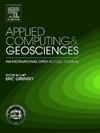印度火山覆盖沉积盆地电阻率成像及不确定度评价新策略
IF 3.2
Q2 COMPUTER SCIENCE, INTERDISCIPLINARY APPLICATIONS
引用次数: 0
摘要
在玄武岩覆盖的地区,如印度的索拉什特拉,德干圈闭是印度岩石圈的重要组成部分,具有显著的地球物理异常和构造-热历史,可追溯到中生代。大地电磁成像是这些地区第三系和第四纪地层的常用成像方法。受鲸鱼捕猎行为的启发,我们评估了改进狼优化(IWOA)策略,该策略可以在不依赖地震和钻孔数据的情况下增强玄武岩覆盖地区的电阻率结构。首先在代表地质情景的理论/合成MT数据集上进行测试,然后将IWOA应用于来自潜在油气盆地的现场数据:(i)圈闭覆盖区域,仅使用MT就可以获得可靠的地下模型;(ii)被导电第三纪沉积物覆盖的圈闭。采用贝叶斯后验概率密度函数(PDF)重建模型,而不是选择误差最小的全局模型。该方法考虑PDF值高于68.27%置信区间的模型,从这些模型构建不确定性较小的平均模型。我们的分析表明,在坎贝盆地火山覆盖层上有一层厚的次盖层第三纪沉积层。该方法还确定了两层:一个可能是冲积层的高导电层和一个可能是火山沉积物的主要电阻层。这些发现与地质地层学和钻井样品相一致,表明IWOA提供了可靠且优越的地下模型。本文章由计算机程序翻译,如有差异,请以英文原文为准。
Resistivity imaging and uncertainty assessment of volcanic covered sedimentary basins of India derived from a new strategy
In basalt-covered areas like Saurashtra, India, the Deccan Traps are a significant part of the Indian lithosphere with notable geophysical anomalies and tectono-thermal history dating back to the Mesozoic. Magnetotellurics (MT) is commonly used to image subtrappean Tertiary and Quaternary strata in these regions. We assessed the Improved Wolf Optimization (IWOA) strategy, inspired by whale hunting behavior, to enhance the electrical resistivity structure in basalt-covered regions without relying on seismic and borehole data. Initially tested on theoretical/synthetic MT datasets representing geological scenarios, IWOA was then applied to field data from hydrocarbon potential basins: (i) trap-covered areas, yielding reliable subsurface models with MT alone, and (ii) traps overlain by conductive Tertiary sediments. Instead of selecting the global model with the lowest error, we used Bayesian posterior probability density function (PDF) to reconstruct models. This approach considers models with PDF values above 68.27 % confidence interval, constructing an average model from these models with lesser uncertainty. Our analysis revealed a thick subtrappean Tertiary sedimentary layer over volcanic cover in the Cambay basin. The method also identified two layers: a highly conductive layer likely alluvium and a major resistive layer probably due to volcanic deposits. These findings align with geological stratigraphy and drill samples, demonstrating that IWOA provides a reliable and superior subsurface model.
求助全文
通过发布文献求助,成功后即可免费获取论文全文。
去求助
来源期刊

Applied Computing and Geosciences
Computer Science-General Computer Science
CiteScore
5.50
自引率
0.00%
发文量
23
审稿时长
5 weeks
 求助内容:
求助内容: 应助结果提醒方式:
应助结果提醒方式:


